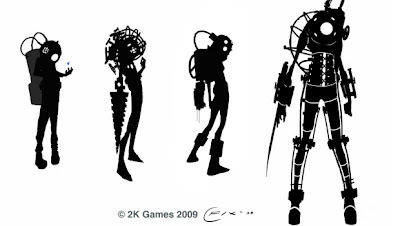Ian Chachere's Scouts
Uh oh, Spaaace Zombies! Courtesy of the masterly Alex Munn
PROJECT 4: Character Finale
Pick at least five of your characters and create finished concepts for them. Here are the guidelines.
1. Create a finished full-color image of each of your characters. Consider the final format your character is to end up in. For a film, stage, or 3D game character, you'll be making a color image for another artist to model or construct. See Alex Munn, Daarken or other production artists for their approach to a final concept. If your characters are designed for 2D animation, or comics, create some "beauty shots" showing what these characters will look like in action. Focus on clarifying your approach to line and color. Regardless of your approach, emphasize clarity. These images are meant to answer questions, not raise them. If you don't know how to draw the gun/sword/purse your character needs to be carrying, now is the time to figure out how to draw that gun/sword/purse!!!
2. Create a set of character schematics for each character. Each schematic should show front, side, and back views and should keep consistent scale. The height of the character in both views should be the same. Again clarity is key in these images. Be careful not to lose your silhouette and dynamic proportions in these images. Keep the drawings alive! If a top view would be useful, you can include that too, but it is not required.
3. Make sure your images are a minimum of 3000 pixels along their longest dimensions. That will give you a decent 8 x 10 print. Feel free to work bigger, but after a certain point there's a trade-off between resolution and computer performance. Don't cause yourself unnecessary pain.
4. Write a brief character biography. Live it up. Be creative. Write in a style conducive to your project. An objective 3rd person approach is 100% fine, but you could also write in first person, in the style of your book or comic, stream of consciousness etc.
5. Organize your work into a clear set of presentation sheets. Include additional sketches or earlier concept work to supplement your primary images.
All components of the project are due before the beginning of class WEDNESDAY, February 5. Schedule your time and keep yourself on deadline. Do not neglect to complete any part of the project. No late work. This is also the drop-dead date for all projects you have been assigned to date. NO LATE WORK WILL BE ACCEPTED AFTER WEDNESDAY, FEBRUARY 5.
READING
Concept Artist Interview with Thomas Jung
Concept Artist Interview with Daren Horley
REFLECTIVE ESSAY
Did the article help your approach or give you insight into the process? After the reading the article, do you actually want to be a concept artist? If so, what areas do you need to work on? I find that my conception of a character tends to change the more I draw it. Was this true for you? If so, how has your character evolved over the past few weeks? Did you have any rough patches while doing your finished work? Were there elements of your character you found that you had no idea how to draw from certain angles? How did you address these blind spots? I've found there is often a point where a character goes from having "a" sword to needing to have a very specific sword, and this need drives my visual research. Did you do additional visual research to clear up weak spots in your design? Did you end up simplifying or streamlining your character the more you drew it? Did you focus on visual clarity and readability of the character? Man, I hope so!
T'is in fact, clobbering time: Ben Grimm evolves!
GRADING
















